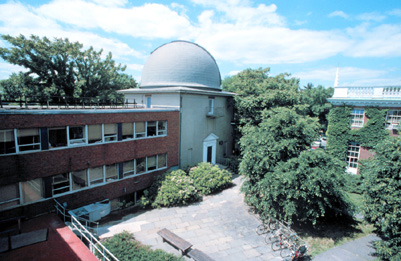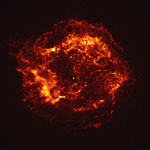An overview of the Chandra mission and goals, Chandra's namesake, top 10 facts.
Classroom activities, printable materials, interactive games & more.
Overview of X-ray Astronomy and X-ray sources: black holes to galaxy clusters.
All Chandra images released to the public listed by date & by category
Current Chandra press releases, status reports, interviews & biographies.
A collection of multimedia, illustrations & animations, a glossary, FAQ & more.
A collection of illustrations, animations and video.
Chandra discoveries in an audio/video format.
Disclaimer: This material is being kept online for historical purposes. Though accurate at the time of publication, it is no longer being updated. The page may contain broken links or outdated information, and parts may not function in current web browsers. Visit chandra.si.edu for current information.
Chandra People: Behind the Scenes, Continued
May 15, 2000 ::

The Chandra X-ray Center provides researchers with support that includes data processing and a science data archive. The Center is operated for NASA by the Smithsonian
Astrophysical Observatory and is situated on the campus of Harvard University.
|
Now that Chandra has moved into the science operations phase, we have asked some people working at the Chandra X-ray Center to answer a brief questionnaire.
The questions are designed to give examples of the work being done at the Center, and to provide some insight into how people feel about their work. Responses will be presented in the Chronicle
during the coming weeks. In this issue, we look at astrophysicist Pat Slane and computer specialist Anil Dosaj of the Chandra Science Mission Planning group

Pat Slane |
Pat Slane
Q: What are your areas of research interest (i.e. stars, black holes, galaxies, clusters)?
A: Supernova remnants (SNRs) and young neutron stars.
Q: Are you using Chandra images in your research?
A: Yes.
 Q: If so, Which image(s)?
A:
Q: If so, Which image(s)?
A: My colleagues and I have carried out studies using Chandra data from the supernova remnants Cas A and G21.5-0.9. These are both calibration data sets which are
publicly available. I am also involved in studies of the remnants N103B and G292.0+1.8 using Chandra data acquired as part of the ACIS team's guaranteed observing time program. I also have three
Chandra observations approved for Cycle 1 observations, but which have yet to be carried out. These are observations of the supernova remnants 3C58, Kes 73, and G347.3-0.5.
 Q:
How are these images changing your particular area of research? (Give an example.)
A:
Q:
How are these images changing your particular area of research? (Give an example.)
A: The excellent angular resolution provided by Chandra is of particular importance to studies of SNRs, and it is no surprise to researchers in this field that some of
the most beautiful images Chandra has obtained are of SNRs (though the details themselves have often been surprising indeed!). G21.5-0.9 is a good example. This SNR has been known as an object
similar to the Crab Nebula in that its previous radio and X-ray observations have revealed the type of emission expected from a nebula powered by a young pulsar. However, in the case of G21.5-0.9, no
compact source was observed in the center. The Chandra observations clearly reveal a central compact source - but one which is ever so slightly extended; we are not seeing the actual neutron star
but, rather, some extended emission that is perhaps created when the pulsar wind meets the resistance provided by the magnetic pressure in the rest of the nebula. This could be the reason for not
detecting pulsations from the central source; there may be a central pulsar, but much of the X-ray emission seem to come from this unpulsed wind region.
The Chandra data also allowed us to discover changes in the X-ray spectrum as one moves away from the center of the nebula. The outer regions of the nebula contain relatively fewer high-energy
X-rays. This is exactly what we expect if the electrons producing the X-rays are injected by a pulsar in the center; the more energetic electrons burn up their energy more rapidly in the nebula's
magnetic field and can't make it as far away from the pulsar as the lower energy electrons can.
For one of my upcoming observations, we will be investigating what may be the youngest known neutron star. It is located at the center of the SNR 3C58 and is believed to have originated in an
explosion from the year 1181. However, unlike the Crab pulsar, this source is quite faint. With the excellent quality of the Chandra mirrors, we will separate this source from the surrounding
emission and, for the first time, get a detailed look at its spectrum which will allow us to identify what processes are responsible for its X-ray output, and determine why it is so different from
the very bright Crab pulsar.
Q: What would you suggest for future X-ray astronomy missions?
A: For the field of SNR science, the most important advance would be the capability to obtain high resolution spectra
from small regions of remnants. With Chandra, the transmission gratings provide high spectral resolution, which allows us to identify specific emission and absorption features in different objects,
but this works only for sources that are point-like or with relatively small angular extent. Because SNRs are typically large, this capability isn't available except for those which are very distant
(such as the remnant E0102-72.3 in the Large Magellanic Cloud), and thus small in angular extent.
One way to solve this problem is to use special detectors, called calorimeters, which offer much higher spectral resolution than the CCD detectors used on Chandra without the gratings. Currently, it
is difficult to make these calorimeters very large, however, and so mapping a large SNR would take a considerable amount of time. Unfortunately, even this capability is not currently available
because of the tragic loss of the Astro-E observatory which failed to reach orbit earlier this year; it carried such a calorimeter, and many of the observations planned for the first year were indeed
studies of SNRs. A replacement for this lost observatory should be a high priority for the field of X-ray astronomy. Ultimately, development of larger calorimeters, coupled with large mirrors with
fairly good optical quality, would provide a huge breakthrough in SNR research.

Anil Dosaj |
Anil Dosaj
Q: What are your duties at the CXC?
A: I work as a Computer Specialist for Science Mission Planning. My major duties are to help plan one week's worth of a schedule once every 5 weeks or so and to be
on-call for that week (to field any TOOs -target of opportunities- or anomalies). Generally it takes about 3 weeks of lead time to
prepare a one week schedule. Other duties are numerous, including writing CDs, generating scripts to do various tasks, making web pages, and doing any general tasks to aide in the normal day-to-day
operations of the Observatory.
On occasion I also moonlight as a Mac consultant for the CXC.
Q: What did you do today? A: Today I generated review products from the schedule for others to review. I
reviewed the "load" (the program that is sent up to direct Chandra's operation for a week) for Science Mission Planning items and represented Science Mission Planning at the Load Review. I worked on
data reduction for ChaMP (the Chandra Multiwavelength Project) and went for coffee.
Q: Have you worked on other major space telescope projects?
A: No, this is my first "real" job after finishing school.
Q: What do you like least about your work with Chandra?
A: Having to make web based help pages for various Mission Planning procedures!
 Q: What do you like most
about your work with Chandra?
A: Never having to do the same things everyday. Everyday is unique in its own way, there is no real routine to my work day - except for morning and afternoon coffee, of
course!
Q: What do you like most
about your work with Chandra?
A: Never having to do the same things everyday. Everyday is unique in its own way, there is no real routine to my work day - except for morning and afternoon coffee, of
course!
Disclaimer: This material is being kept online for historical purposes. Though accurate at the time of publication, it is no longer being updated. The page may contain broken links or outdated information, and parts may not function in current web browsers. Visit chandra.si.edu for current information.










